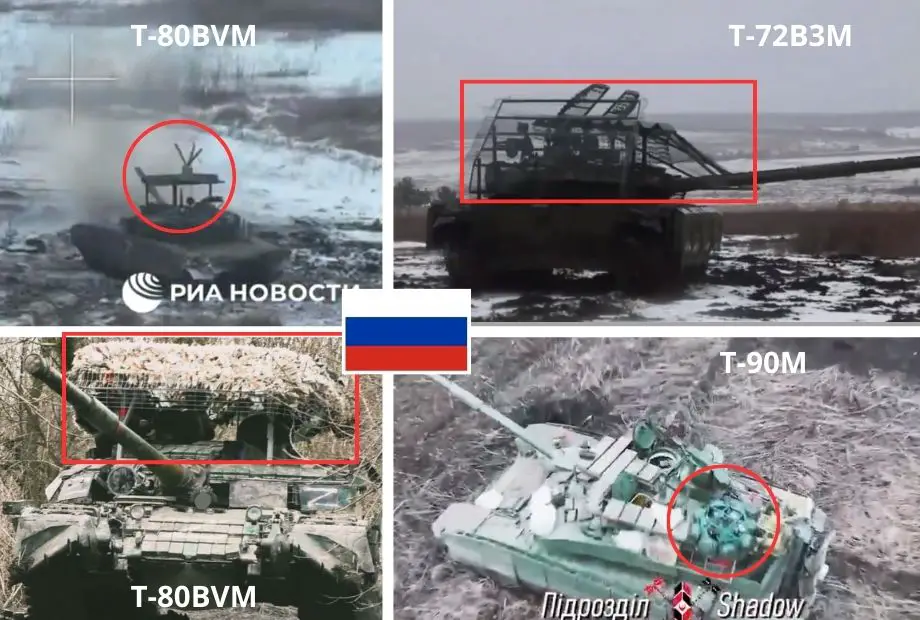In recent images from conflict zones, several Russian combat tanks have been seen with artisanal modifications suited to the terrain. Notably, these include camouflage nets, anti-drone jammers, and cage-like superstructures designed to protect the vehicles from various battlefield threats, particularly militarized drone droppers that can discreetly drop grenades with high precision into the tank hatches.
Follow Army Recognition on Google News at this link

Video captures of artisanally modified Russian MBT (Picture source OSINT+armyrecognition )
In addition to various versions, the Russian army currently operates three models of main battle tanks: the T-72 (specifically the T-72B3M variant), the T-80 and its multiple upgrades, and the T-90M. The T72, introduced into service towards the end of its development in the 1980s, is the main battle tank of the Russian army. However, it has been gradually replaced since the 2000s by the T90 and T90M. Nonetheless, technological advancements have led to the modernization of the T72, resulting in the introduction of the T72B3M in 2017, which has now joined the Russian armed forces and is currently deployed in Ukraine.
The B3M version of the T72 boasts several significant improvements compared to its predecessor. This includes upgrades in protection, with the addition of reactive armor on the turret and glacis, as well as the installation of an active defense system against anti-tank missiles. Furthermore, it incorporates enhancements in mobility, thanks to a more powerful engine and modernized fire control systems, providing better accuracy and improved firepower, thereby enhancing its versatility and effectiveness on the modern battlefield.
The T-80 is a Soviet-designed main battle tank that first entered production in the 1970s, representing a significant advancement in armored warfare technology. Distinguished by its incorporation of a gas turbine engine in addition to a diesel engine, the T-80 offers high speed and agility on the battlefield, capable of reaching up to 70 km/h. It is heavily armored and armed with a 125mm smoothbore cannon capable of firing a variety of munitions, including guided missiles, a capability that enhances its role in direct fire support. Over the years, the T-80 has undergone several upgrades to improve its combat effectiveness and survivability, with variants like the T-80U and T-80BV featuring modern reactive armor and enhanced targeting systems
The T-90 is a third-generation Russian main battle tank, which first entered service in the early 1990s as a substantial evolution of the T-72B, incorporating technology from the T-80 series. It is equipped with a powerful 125mm smoothbore cannon capable of firing high-explosive, armor-piercing, and guided missile ammunition, making it versatile on the modern battlefield. The T-90 features advanced armor protection, including composite armor and the Shtora-1 countermeasures system, designed to disrupt the guidance systems of incoming anti-tank missiles. This tank is further enhanced with modern electronics and night vision equipment, improving its operational capabilities in various combat scenarios.
The main battle tank, deployed in Ukraine, faces the actions of FPV drones and militarized civilian drones. These drones operate in three stages: detection, approach, and strike. Consequently, the Russians have developed countermeasures to complicate these three phases and thereby reduce the losses of these aging tanks.
The tank is notably draped in a camouflage net, indicating a strategic adaptation to reduce its visual and infrared signature. This is particularly significant in an age where surveillance and reconnaissance technology can pinpoint targets with devastating accuracy. The netting, resembling foliage, enables the tank to blend with the natural environment, complicating detection efforts by enemy forces.
Phase 1: Countermeasure to Detection
The tank is notably draped in a camouflage net, indicating a strategic adaptation to reduce its visual signature. This is particularly significant in an era where surveillance and reconnaissance technology can locate targets with devastating precision. The net, resembling vegetation, allows the tank to blend into the natural environment, complicating enemy detection efforts.
Indeed, the unique feature of this camouflage net is that it distorts the straight lines that outline the tank, distinguishing it from its surroundings. However, this system is not foolproof as it is suitable for detections in daylight and at night vision, but it does not conceal heat emissions, particularly visible with infrared technology.
Phase 2: Countermeasure to Approach
The particularity of drones is that they use radio frequency communication, which may be their only vulnerability. Therefore, a jamming system is observed at the front of the turret. This system aims to disrupt the link between the drone and its operator, rendering it inoperative and its strike imprecise. In some cases, this causes the drone to crash to the ground.
Phase 3: Countermeasure to Strike
In case the previous countermeasures prove insufficient, the tank is equipped not only with traditional RPG anti-missile screens around its hull but also with anti-RPG screens installed from the outset on the turret superstructure to limit the effect of top-attack missiles like the Javelin. Today, these screens have a finer mesh to slow down and deflect the shots of grenades carried by militarized civilian drones.
All of these improvements highlight the rather makeshift developments made by units to limit Russian losses within the cavalry. There is a combination of high technology and craftsmanship, making these improvements specific and not resulting from a linear improvement of the entire series.
However, the presence of jammers is becoming increasingly common on Russian tanks, betraying a real fear of civilian drones by the Russians. And rightly so, as drones represent silent, undetectable, and highly precise strikes.
It will be interesting to see if these developments, which are currently unit-led initiatives, will become common in the next official iterations of Russian battle tanks. For the moment, several tanks equipped with cage and jamming systems have been destroyed.
Defense News April 2024
















